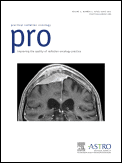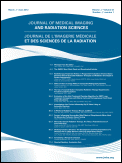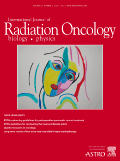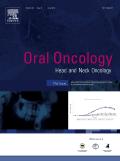
Practical Radiation Oncology
Scope & Guideline
Advancing the Frontiers of Radiation Oncology
Introduction
Aims and Scopes
- Clinical Research and Trials:
The journal emphasizes original research, particularly clinical trials that evaluate the efficacy and safety of radiation therapy across various cancer types, including prostate, breast, and head and neck cancers. - Technological Advancements:
There is a consistent focus on the integration of new technologies in radiation therapy, including MRI-guided therapy, stereotactic body radiation therapy (SBRT), and artificial intelligence applications for treatment planning. - Multidisciplinary Approaches:
The journal highlights the importance of collaborative practices in oncology, showcasing studies that involve multidisciplinary teams for comprehensive cancer care. - Patient-Centered Outcomes:
Research addressing patient-reported outcomes and quality of life post-treatment is a core area, emphasizing the importance of patient experiences in evaluating treatment effectiveness. - Guidelines and Best Practices:
The journal plays a crucial role in disseminating clinical practice guidelines and consensus statements that shape standard care practices in radiation oncology.
Trending and Emerging
- Integration of Artificial Intelligence:
There is a rising trend in the application of artificial intelligence for treatment planning and predictive modeling in radiation oncology, showcasing the journal's commitment to incorporating cutting-edge technology. - Personalized and Adaptive Radiation Therapy:
Emerging studies are focusing on personalized treatment plans and adaptive radiation therapy strategies, indicating a shift towards tailored approaches that consider individual patient factors. - Immunotherapy and Radiation Synergy:
Research exploring the combination of immunotherapy with radiation treatment is gaining traction, reflecting a growing interest in optimizing treatment regimens for various cancer types. - Quality Assurance and Safety Practices:
An increasing number of articles are addressing quality assurance protocols and safety practices within radiation oncology, underlining the field's commitment to enhancing treatment reliability and patient safety. - Patient-Reported Outcomes and Quality of Life:
There is a notable increase in studies emphasizing patient-reported outcomes, highlighting the importance of patient experiences and satisfaction in evaluating the effectiveness of radiation therapy.
Declining or Waning
- Traditional Radiation Techniques:
There is a noticeable decline in studies centered on conventional radiation techniques, as the field shifts towards more advanced methods like SBRT and adaptive radiation therapy. - Basic Science Research:
Research articles focused on the fundamental biological mechanisms of radiation therapy are less frequent, indicating a potential shift towards clinical applications and outcomes. - Palliative Care Studies:
The focus on palliative radiation therapy is waning, possibly due to a growing emphasis on curative approaches and the integration of systemic therapies with radiation.
Similar Journals

Translational Oncology
Innovating Tomorrow's Cancer Therapies TodayTranslational Oncology is a premier open access journal published by Elsevier Science Inc, dedicated to the rapidly evolving field of cancer research and oncology. Since its inception in 2008, the journal has been a vital platform for the dissemination of innovative research and findings that bridge the gap between laboratory discoveries and clinical applications. With an impressive impact factor and ranked Q2 in Cancer Research and Q1 in Oncology, it occupies a prominent position in the academic landscape, helping to shape the future of cancer therapeutics and patient care. The journal offers valuable insights across a diverse array of topics, including molecular biology, genetic factors in cancer, and innovative treatment strategies, ensuring relevance and engagement for its readership. As it converges toward 2024, Translational Oncology continues to attract a global audience of researchers, healthcare professionals, and students committed to advancing our understanding of cancer and enhancing clinical outcomes.

Radiation Oncology Journal
Unveiling breakthroughs in therapeutic radiology for a healthier tomorrow.Radiation Oncology Journal, published by the Korean Society of Therapeutic Radiology & Oncology, stands at the forefront of cancer treatment research and innovation within the dynamic fields of oncology and radiology. With a focus on disseminating groundbreaking findings and advancements from 2012 to 2024, this journal aims to foster collaboration among researchers, clinicians, and educators dedicated to improving therapeutic techniques and patient outcomes in the context of radiation therapy. Recognized with a prestigious Q2 ranking in both the Oncology and Radiology, Nuclear Medicine and Imaging categories, it ranks 140th out of 333 in its Scopus category for Medicine Radiology and boasts a 58th percentile placement. While operating on a non-open access basis, the journal remains committed to providing valuable insights and updates to professionals in the field from its base in South Korea. As the landscape of cancer treatment evolves, the Radiation Oncology Journal continues to play a vital role in shaping research trends and enhancing the understanding of radiotherapy's role in comprehensive cancer care.

Radiological Physics and Technology
Innovating the future of radiation technology.Radiological Physics and Technology, published by SPRINGER JAPAN KK, is a prominent journal that serves as a crucial resource in the multidisciplinary fields of medicine and radiation sciences. With an ISSN of 1865-0333 and an E-ISSN of 1865-0341, the journal has been converging impactful research from 2008 to 2024. It holds a commendable position in academic rankings, currently classified in Q2 in Physical Therapy, Sports Therapy and Rehabilitation and Radiation, along with Q3 for Medicine (miscellaneous) and Radiology, Nuclear Medicine and Imaging. The journal is well-regarded in the academic community, reflected in its Scopus rankings that place it in the upper tiers of its respective categories. Although it currently does not offer Open Access, Radiological Physics and Technology remains a pivotal publication for researchers, academics, and practitioners seeking to advance knowledge and foster innovation in radiological science. Its commitment to disseminating high-quality research ensures its continued relevance and importance within these fields.

International Journal of Particle Therapy
Innovating Radiation Therapy for a Healthier TomorrowInternational Journal of Particle Therapy, an esteemed publication from the INT JOURNAL PARTICLE THERAPY, stands at the forefront of innovative research in the realms of particle therapy, radiology, and atomic physics. Established as an Open Access journal since 2015, it provides a platform for scholarly articles that drive the advancement of knowledge and practice in cancer treatment and radiation therapy. With an impact factor reflective of its rising stature, this journal has been categorized in the Q2 quartile for both Atomic and Molecular Physics and Radiology, Nuclear Medicine and Imaging as of 2023, illustrating its significant role in contributing to these vital fields. Researchers, professionals, and students alike will find the journal indispensable for accessing pioneering studies that explore the efficacy and application of particle therapy, ensuring that the latest advancements reach a broad audience. With a robust focus on bridging theoretical insights and clinical practices, the International Journal of Particle Therapy remains committed to enhancing patient outcomes and fostering collaboration among scientists worldwide.

Journal of Radiosurgery and SBRT
Pioneering Research in Radiosurgery ExcellenceJournal of Radiosurgery and SBRT is a dedicated platform for advancing the field of radiosurgery and stereotactic body radiation therapy (SBRT), published by OLD CITY PUBLISHING INC. With its ISSN 2156-4639 and E-ISSN 2156-4647, this journal serves researchers and practitioners keen on the latest findings and methodologies in the domains of radiological technology and surgical oncology. Operating from Spain, the journal has established itself within notable quartiles, ranking Q3 in 2023 across categories including Radiological and Ultrasound Technology, Radiology, Nuclear Medicine and Imaging, and Surgery. The journal is indexed in Scopus, with rankings that place it at #311 in Medicine Surgery and #232 in Medicine Radiology categories, reflecting its significance in the academic community. Although it does not currently offer an open-access model, the Journal of Radiosurgery and SBRT aims to foster innovation and collaboration, making it an essential resource for those involved in cutting-edge research and clinical practice in radiosurgery.

Japanese Journal of Radiology
Transforming Radiological Science with Cutting-Edge ResearchThe Japanese Journal of Radiology, published by SPRINGER, serves as a premier platform for disseminating cutting-edge research and clinical advancements in the fields of radiology, nuclear medicine, and imaging. With an ISSN of 1867-1071 and E-ISSN 1867-108X, this journal has established itself as a vital resource for practitioners, researchers, and students alike. Renowned for its high-quality peer-reviewed articles, it currently enjoys a respectable impact factor within the Q2 category of Scopus rankings, placing it in the 69th percentile among 333 journals in its field. The journal has seen consistent convergence of research from 2009 to 2024, further underscoring its commitment to advancing the understanding of radiological practices. Importantly, the journal offers Open Access options to facilitate widespread dissemination of knowledge, ensuring that vital research reaches its audience without barriers. Addressed in Japan, the Japanese Journal of Radiology plays a critical role in enhancing the global discourse on medical imaging, making it an essential resource for anyone engaged in this dynamic field.

Journal of Medical Imaging and Radiation Sciences
Shaping the future of medical imaging and radiation research.Journal of Medical Imaging and Radiation Sciences, published by Elsevier Science Inc, is a prominent platform dedicated to advancing research and knowledge in the field of medical imaging and radiation sciences. With an ISSN of 1939-8654, this journal plays a crucial role in disseminating innovative studies and insights from 2008 to 2024, providing a valuable resource for researchers, professionals, and students alike. It is positioned within the Q3 quartile in both the categories of Radiological and Ultrasound Technology and Radiology, Nuclear Medicine and Imaging, indicating its growing influence and contributions to these critical areas of healthcare. While it currently does not offer open access, authors benefit from the journal's rigorous peer-review process, ensuring high-quality publications. As the landscape of medical imaging continues to evolve, the Journal of Medical Imaging and Radiation Sciences stands out for its commitment to education and innovation, inviting contributions that explore the latest technological advancements and clinical applications.

ACTA ONCOLOGICA
Advancing the frontiers of cancer research.ACTA ONCOLOGICA is a prestigious multidisciplinary journal published by Medical Journal Sweden AB, dedicated to advancing cancer research and clinical practice. As a key resource in the field of oncology, the journal aims to publish high-quality articles that cover significant developments in cancer biology, treatment modalities, and innovative imaging techniques. With an ISSN of 0284-186X and an E-ISSN of 1651-226X, ACTA ONCOLOGICA operates in the United Kingdom and is recognized for its substantial impact, currently holding a Q2 ranking in the categories of Hematology, Medicine (miscellaneous), Oncology, and Radiology, Nuclear Medicine and Imaging in 2023. The journal’s commitment to disseminating pivotal research is reflected in its inclusion in Scopus, with rankings placing it in the top half of its fields. Though it does not currently offer Open Access, it remains an essential resource for researchers, healthcare professionals, and students seeking to stay informed on the latest trends and findings in oncology. Established in 1963, the journal continues to be a cornerstone of cancer research well into 2024.

INTERNATIONAL JOURNAL OF RADIATION ONCOLOGY BIOLOGY PHYSICS
Unveiling Breakthroughs in Cancer Care and Research.International Journal of Radiation Oncology Biology Physics, published by Elsevier Science Inc, is a premier academic journal that has played a critical role in advancing the field of radiation oncology since its inception in 1975. With an impressive impact factor and recognition as a Q1 journal across multiple categories such as Cancer Research, Oncology, and Radiology, this journal serves as a vital resource for researchers, clinicians, and students dedicated to understanding and improving cancer treatment modalities. Its multifaceted scope encompasses original research, reviews, and innovative clinical studies, fostering a deeper understanding of the interplay between radiation, biology, and oncology. With a remarkable ranking in Scopus, including a top position in Radiation Physics and an elite percentile in Oncology, IJROBP remains at the forefront of scientific discovery and innovation in the management of cancer. A traditional subscription model ensures high-quality, peer-reviewed content, providing invaluable insights that continue to advance the standards of care and research in radiation oncology.

ORAL ONCOLOGY
Pioneering Discoveries in Oral Disease ManagementORAL ONCOLOGY is a leading peer-reviewed journal published by Elsevier, dedicated to advancing the field of oncology with a specific focus on oral diseases and cancers. Since its inception in 1996, this esteemed journal has provided a platform for high-quality research that addresses critical issues in oral surgery, cancer research, and related disciplines. With impressive rankings in Q1 in Oncology and Q1 in Oral Surgery, and recognized as Rank #1 in Dentistry and Oral Surgery by Scopus, ORAL ONCOLOGY consistently publishes impactful articles that contribute significantly to our understanding of oral cancers. The journal is committed to sharing pioneering findings that enhance clinical practices and improve patient outcomes. As a non-open access journal, it provides readers with exclusive access to cutting-edge research, ensuring that professionals, researchers, and students are at the forefront of developments in the field. Situated in the United Kingdom, ORAL ONCOLOGY serves as an indispensable resource for those dedicated to advancing oral health and oncology research through rigorous scientific inquiry and collaboration.